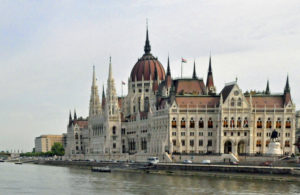
Parliament Building in Budapest, Hungary (Photo by Don Knebel)
Budapest was formed in 1873 by the merger of Buda, a city on hills west of the Danube River, and Pest, a city on the flat areas east of the river. The cities were joined physically in 1849 by the “Chain Bridge,” a large suspension bridge completed 24 years before the Brooklyn Bridge. Even before their official merger, the cities jointly served as co-capital of Austria-Hungary, a powerful empire that existed from 1867 to 1918. During the height of the Empire, the Hungarian Parliament Building was constructed along the Danube on the Pest side. The river front façade of this elaborate Gothic Revival style building is six feet wider than that of London’s Palace of Westminster, whose design inspired it. Today, Budapest’s parliament building in the world’s third largest. Budapest also includes what is said to be the world’s second largest synagogue, completed in 1859 in a Moorish style reflecting the good relationship between Budapest’s Jews and Muslims when the city was controlled by the Islamic Ottoman Empire in the sixteenth and seventeenth centuries.
Picturesque Castle Hill, across the Danube from the parliament building, includes the imposing Buda Castle and the fourteenth century Matthias Church. The church held the coronation of Charles IV of Hungary, the last ruler of Austria-Hungary, who renounced the Empire after its defeat in World War I. Today the church roof is covered in bright orange Zsolnay tiles, invented in Hungary.
In October 2013, readers of Condé Nast Traveler named Budapest the “world’s top city.” It is certainly among them.